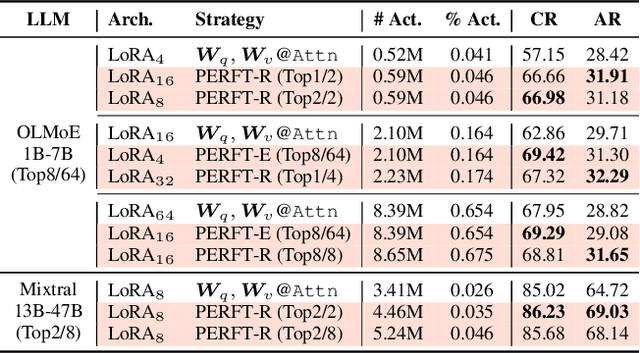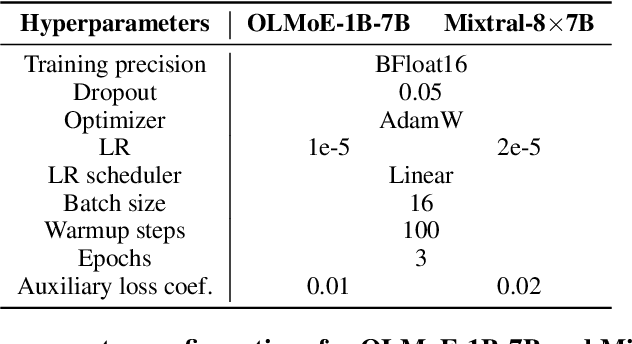Volker Tresp
Supposedly Equivalent Facts That Aren't? Entity Frequency in Pre-training Induces Asymmetry in LLMs
Mar 28, 2025Abstract:Understanding and mitigating hallucinations in Large Language Models (LLMs) is crucial for ensuring reliable content generation. While previous research has primarily focused on "when" LLMs hallucinate, our work explains "why" and directly links model behaviour to the pre-training data that forms their prior knowledge. Specifically, we demonstrate that an asymmetry exists in the recognition of logically equivalent facts, which can be attributed to frequency discrepancies of entities appearing as subjects versus objects. Given that most pre-training datasets are inaccessible, we leverage the fully open-source OLMo series by indexing its Dolma dataset to estimate entity frequencies. Using relational facts (represented as triples) from Wikidata5M, we construct probing datasets to isolate this effect. Our experiments reveal that facts with a high-frequency subject and a low-frequency object are better recognised than their inverse, despite their logical equivalence. The pattern reverses in low-to-high frequency settings, and no statistically significant asymmetry emerges when both entities are high-frequency. These findings highlight the influential role of pre-training data in shaping model predictions and provide insights for inferring the characteristics of pre-training data in closed or partially closed LLMs.
Memory Helps, but Confabulation Misleads: Understanding Streaming Events in Videos with MLLMs
Feb 21, 2025Abstract:Multimodal large language models (MLLMs) have demonstrated strong performance in understanding videos holistically, yet their ability to process streaming videos-videos are treated as a sequence of visual events-remains underexplored. Intuitively, leveraging past events as memory can enrich contextual and temporal understanding of the current event. In this paper, we show that leveraging memories as contexts helps MLLMs better understand video events. However, because such memories rely on predictions of preceding events, they may contain misinformation, leading to confabulation and degraded performance. To address this, we propose a confabulation-aware memory modification method that mitigates confabulated memory for memory-enhanced event understanding.
PRISM: Self-Pruning Intrinsic Selection Method for Training-Free Multimodal Data Selection
Feb 17, 2025Abstract:Visual instruction tuning refines pre-trained Multimodal Large Language Models (MLLMs) to enhance their real-world task performance. However, the rapid expansion of visual instruction datasets introduces significant data redundancy, leading to excessive computational costs. Existing data selection methods predominantly rely on proxy models or loss-based metrics, both of which impose substantial computational overheads due to the necessity of model inference and backpropagation. To address this challenge, we propose PRISM, a novel training-free approach for efficient multimodal data selection. Unlike existing methods, PRISM eliminates the reliance on proxy models, warm-up pretraining, and gradient-based optimization. Instead, it leverages Pearson correlation analysis to quantify the intrinsic visual encoding properties of MLLMs, computing a task-specific correlation score to identify high-value instances. This not only enbles data-efficient selection,but maintains the original performance. Empirical evaluations across multiple MLLMs demonstrate that PRISM reduces the overall time required for visual instruction tuning and data selection to just 30% of conventional methods, while surpassing fully fine-tuned models across eight multimodal and three language understanding benchmarks, achieving a 101.7% relative improvement in final performance.
FocalPO: Enhancing Preference Optimizing by Focusing on Correct Preference Rankings
Jan 11, 2025



Abstract:Efficient preference optimization algorithms such as Direct Preference Optimization (DPO) have become a popular approach in aligning large language models (LLMs) with human preferences. These algorithms implicitly treat the LLM as a reward model, and focus on training it to correct misranked preference pairs. However, recent work~\citep{chen2024preference} empirically finds that DPO training \textit{rarely improves these misranked preference pairs}, despite its gradient emphasizing on these cases. We introduce FocalPO, a DPO variant that instead \textit{down-weighs} misranked preference pairs and prioritizes enhancing the model's understanding of pairs that it can already rank correctly. Inspired by Focal Loss used in vision tasks, FocalPO achieves this by adding a modulating factor to dynamically scale DPO loss. Our experiment demonstrates that FocalPO surpasses DPO and its variants on popular benchmarks like Alpaca Eval 2.0 using Mistral-Base-7B and Llama-3-Instruct-8B. Additionally, we empirically reveals how FocalPO affects training on correct and incorrect sample groups, further underscoring its effectiveness.
Perceive, Query & Reason: Enhancing Video QA with Question-Guided Temporal Queries
Dec 26, 2024Abstract:Video Question Answering (Video QA) is a challenging video understanding task that requires models to comprehend entire videos, identify the most relevant information based on contextual cues from a given question, and reason accurately to provide answers. Recent advancements in Multimodal Large Language Models (MLLMs) have transformed video QA by leveraging their exceptional commonsense reasoning capabilities. This progress is largely driven by the effective alignment between visual data and the language space of MLLMs. However, for video QA, an additional space-time alignment poses a considerable challenge for extracting question-relevant information across frames. In this work, we investigate diverse temporal modeling techniques to integrate with MLLMs, aiming to achieve question-guided temporal modeling that leverages pre-trained visual and textual alignment in MLLMs. We propose T-Former, a novel temporal modeling method that creates a question-guided temporal bridge between frame-wise visual perception and the reasoning capabilities of LLMs. Our evaluation across multiple video QA benchmarks demonstrates that T-Former competes favorably with existing temporal modeling approaches and aligns with recent advancements in video QA.
Visual Instruction Tuning with 500x Fewer Parameters through Modality Linear Representation-Steering
Dec 16, 2024



Abstract:Multimodal Large Language Models (MLLMs) have significantly advanced visual tasks by integrating visual representations into large language models (LLMs). The textual modality, inherited from LLMs, equips MLLMs with abilities like instruction following and in-context learning. In contrast, the visual modality enhances performance in downstream tasks by leveraging rich semantic content, spatial information, and grounding capabilities. These intrinsic modalities work synergistically across various visual tasks. Our research initially reveals a persistent imbalance between these modalities, with text often dominating output generation during visual instruction tuning. This imbalance occurs when using both full fine-tuning and parameter-efficient fine-tuning (PEFT) methods. We then found that re-balancing these modalities can significantly reduce the number of trainable parameters required, inspiring a direction for further optimizing visual instruction tuning. We introduce Modality Linear Representation-Steering (MoReS) to achieve the goal. MoReS effectively re-balances the intrinsic modalities throughout the model, where the key idea is to steer visual representations through linear transformations in the visual subspace across each model layer. To validate our solution, we composed LLaVA Steering, a suite of models integrated with the proposed MoReS method. Evaluation results show that the composed LLaVA Steering models require, on average, 500 times fewer trainable parameters than LoRA needs while still achieving comparable performance across three visual benchmarks and eight visual question-answering tasks. Last, we present the LLaVA Steering Factory, an in-house developed platform that enables researchers to quickly customize various MLLMs with component-based architecture for seamlessly integrating state-of-the-art models, and evaluate their intrinsic modality imbalance.
PERFT: Parameter-Efficient Routed Fine-Tuning for Mixture-of-Expert Model
Nov 12, 2024



Abstract:The Mixture-of-Experts (MoE) paradigm has emerged as a powerful approach for scaling transformers with improved resource utilization. However, efficiently fine-tuning MoE models remains largely underexplored. Inspired by recent works on Parameter-Efficient Fine-Tuning (PEFT), we present a unified framework for integrating PEFT modules directly into the MoE mechanism. Aligning with the core principles and architecture of MoE, our framework encompasses a set of design dimensions including various functional and composition strategies. By combining design choices within our framework, we introduce Parameter-Efficient Routed Fine-Tuning (PERFT) as a flexible and scalable family of PEFT strategies tailored for MoE models. Extensive experiments on adapting OLMoE-1B-7B and Mixtral-8$\times$7B for commonsense and arithmetic reasoning tasks demonstrate the effectiveness, scalability, and intriguing dynamics of PERFT. Additionally, we provide empirical findings for each specific design choice to facilitate better application of MoE and PEFT.
FedBiP: Heterogeneous One-Shot Federated Learning with Personalized Latent Diffusion Models
Oct 07, 2024



Abstract:One-Shot Federated Learning (OSFL), a special decentralized machine learning paradigm, has recently gained significant attention. OSFL requires only a single round of client data or model upload, which reduces communication costs and mitigates privacy threats compared to traditional FL. Despite these promising prospects, existing methods face challenges due to client data heterogeneity and limited data quantity when applied to real-world OSFL systems. Recently, Latent Diffusion Models (LDM) have shown remarkable advancements in synthesizing high-quality images through pretraining on large-scale datasets, thereby presenting a potential solution to overcome these issues. However, directly applying pretrained LDM to heterogeneous OSFL results in significant distribution shifts in synthetic data, leading to performance degradation in classification models trained on such data. This issue is particularly pronounced in rare domains, such as medical imaging, which are underrepresented in LDM's pretraining data. To address this challenge, we propose Federated Bi-Level Personalization (FedBiP), which personalizes the pretrained LDM at both instance-level and concept-level. Hereby, FedBiP synthesizes images following the client's local data distribution without compromising the privacy regulations. FedBiP is also the first approach to simultaneously address feature space heterogeneity and client data scarcity in OSFL. Our method is validated through extensive experiments on three OSFL benchmarks with feature space heterogeneity, as well as on challenging medical and satellite image datasets with label heterogeneity. The results demonstrate the effectiveness of FedBiP, which substantially outperforms other OSFL methods.
VideoINSTA: Zero-shot Long Video Understanding via Informative Spatial-Temporal Reasoning with LLMs
Sep 30, 2024



Abstract:In the video-language domain, recent works in leveraging zero-shot Large Language Model-based reasoning for video understanding have become competitive challengers to previous end-to-end models. However, long video understanding presents unique challenges due to the complexity of reasoning over extended timespans, even for zero-shot LLM-based approaches. The challenge of information redundancy in long videos prompts the question of what specific information is essential for large language models (LLMs) and how to leverage them for complex spatial-temporal reasoning in long-form video analysis. We propose a framework VideoINSTA, i.e. INformative Spatial-TemporAl Reasoning for zero-shot long-form video understanding. VideoINSTA contributes (1) a zero-shot framework for long video understanding using LLMs; (2) an event-based temporal reasoning and content-based spatial reasoning approach for LLMs to reason over spatial-temporal information in videos; (3) a self-reflective information reasoning scheme balancing temporal factors based on information sufficiency and prediction confidence. Our model significantly improves the state-of-the-art on three long video question-answering benchmarks: EgoSchema, NextQA, and IntentQA, and the open question answering dataset ActivityNetQA. The code is released here: https://github.com/mayhugotong/VideoINSTA.
Visual Question Decomposition on Multimodal Large Language Models
Sep 28, 2024



Abstract:Question decomposition has emerged as an effective strategy for prompting Large Language Models (LLMs) to answer complex questions. However, while existing methods primarily focus on unimodal language models, the question decomposition capability of Multimodal Large Language Models (MLLMs) has yet to be explored. To this end, this paper explores visual question decomposition on MLLMs. Specifically, we introduce a systematic evaluation framework including a dataset and several evaluation criteria to assess the quality of the decomposed sub-questions, revealing that existing MLLMs struggle to produce high-quality sub-questions. To address this limitation, we propose a specific finetuning dataset, DecoVQA+, for enhancing the model's question decomposition capability. Aiming at enabling models to perform appropriate selective decomposition, we propose an efficient finetuning pipeline. The finetuning pipeline consists of our proposed dataset and a training objective for selective decomposition. Finetuned MLLMs demonstrate significant improvements in the quality of sub-questions and the policy of selective question decomposition. Additionally, the models also achieve higher accuracy with selective decomposition on VQA benchmark datasets.
 Add to Chrome
Add to Chrome Add to Firefox
Add to Firefox Add to Edge
Add to Edge